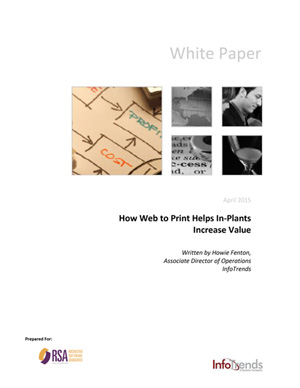- Howie Fenton
- |
- April 27, 2015

One of the interesting web to print puzzles is why most implementations succeed while others fail. In NAPL's (now Epicomm) 2013 research, "Web to Print: the Promise, the Potential, and the Reality," more than half of those surveyed said web to print had increased sales and two thirds said it streamlined their production workflows. However, 80 percent reported that it has not met their expectations in terms of client usage and the numbers of features accessed. In the NAPL Workflow Investment Survey 2014, while 150 respondents called Web to print their most worthwhile investment, 40
claimed it was their least worthwhile investment. In other words, about 80% of companies are very successful and 20 percent are not. The question is why do some succeed while others fail? It is possible that those who fail are missing the critical success factors. According to the Harvard Business Review, critical success factors are the few essential elements that are required for success. In our work with companies that are successful and those who are struggling, we believe there are three critical factors for success: buy in, responsive solutions and a greater investment.
Motivate Buy-In, Build Better Solutions and Invest
- Motivating buy-in. Not everyone embraces change. It's not unusual in the implementation of any new technology for customers to feel intimidated and uncomfortable with the new system. If left unchecked this can create a climate of dissatisfaction and result in refusal to work with the new systems. How do you avoid that? You have to engage customers with training and support. A mid-west insurance and financial services firm with an in-house printing facility needed to train a large number of staff to use WebCRD and QDirect after purchasing these solutions. They were fortunate to have a Marketing department who could create short instructional videos that could be accessed from any computer. Different videos were created for different divisions that had different requirements, and each video showed the step-by-step process of how to utilize the new software.
- Leaders build better solutions. These are not one-size-fits-all solutions. It's critical to configure the solution to your needs. The mid-west insurance and financial services firm was having problems with their outside vendor who could not keep up with their document warehousing and fulfillment needs. Large volumes of printed materials were sitting in the warehouse, only to be pulped when policies changed or the documents went out of compliance. In addition, they wanted to customize documents to make them more relevant to different groups of customers. Various Web to print vendors were considered but it was clear they would need to integrate several different products with their systems and decided to work with RSA. The goal was to utilize RSA's M.I.S. Print, to convert legacy print streams in its data center, QDirect for Enterprise Output Management, and WebCRD Web to print for ordering and its VDP module to customize templates. Although the predicted savings were $250,000 per year, the system is now delivering $1.5 million per year in savings. Most of the savings come from reduced obsolescence and waste. Watch this video to learn more about this firm's workflow.
- Leaders invest more. As reported in the NAPL Workflow Investment Survey 2014, when companies were asked how much they invested, leaders, regardless of company size, invested more time and money. A larger number of leaders invested in the highest investment category ($25K or more) for Web to print software (32 percent leaders, 26 percent laggards). Digital workflow solution provider, RSA offers a workflow assessment to clients 3-4 months after a solution goes live. RSA typically identifies many workflow automations and improvements to streamline operations based on actual usage of the system, thereby tailoring the solution to each print center.
A government agency, part of the US Department of Interior, went even further. They wanted to build a product that would help maintain low costs, allow customers to search and order documents and automate frequent production tasks. After two unsuccessful efforts with other Web to print solutions, the printing manager had a pretty good idea of what was needed and decided to work with RSA. One goal was for the system to be as easy to work with as world-class e-commerce solutions like Amazon.com. The first step was to scan existing documents and make them searchable and readable. All previous printed jobs were scanned, OCR'ed, and placed into a searchable repository of files. The agency wanted to give customers the ability to combine several publications into one larger book. To do so they needed to add a feature to combine multiple requests into a book with a tab between each section. After that feature was successfully implemented, agency staff created a wish list of new features they wanted and created mock-ups of their ideal user interface. After several face to face meetings, RSA customized the software to meet Reclamation's needs.
Summary
E-commerce or Web to print solutions are not always plug-and-play. Anyone adopting a Field of Dreams philosophy of "If you build it they will come" is often disappointed. By exhibiting the three critical success factors that these in-plants did, they ensured their success.

Want Additional Details?
Additional details about this topic are available in the free white paper, “How Web to Print Helps In-plants Increase Value.”